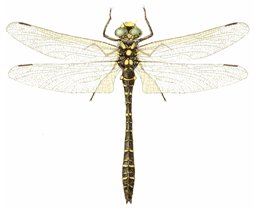 |
Cordulegaster
boltonii
Cordulegaster
annulatus |
 |
|
Common Name:
|
Golden-ringed Dragonfly, Common
Goldenring |
|
Odonata |
|
Order:
|
Odonata |
|
Suborder:
|
Anisoptera |
|
Family:
|
Cordulegastridae |
|
Genus:
|
Cordulegaster |
|
Species:
|
C. boltonii |
|
Synonymy:
|
Cordulegaster annulatus (Latreille,
1805) |
|
|
| The
Name |
| Cordulegaster boltonii (Donovan,
1807), the golden-ringed dragonfly is the most typical and widespread of
the seven European Goldenring species. Its main distinguishing features
include the yellow (rather than black) occipital triangle, and the pairs
of golden rings (one wide; one narrow) on segments 2-8 of the abdomen.
In all Goldenring species, the female lays her eggs by dipping her abdomen
repeatedly in wet mud (or moss, etc.) in a pneumatic drill fashion.
The Family Cordulegastridae are a
family of Odonata (dragonflies) from the suborder Anisoptera. They are
commonly known as Spiketails. Some vernacular names for the species of
this family are biddie and flying adder. The family is distributed world-wide;
all eight species in North America belong to the genus Cordulegaster.
The name Cordulegastridae comes from
the Greek kordylinus, 'club-shaped' and gaster, belly. The common name
spiketails refers to the females' prominent ovipositor.
|
| The
Characteristics |
| Length in male around 74mm, female
84mm, Wingspan approximately 90mm.
A striking, black insect with yellow
rings along the length of the abdomen. Both the thorax and abdomen are
black with bright yellow bands, the legs are black with yellow bases and
the abdomen is swollen towards the tip. The large green eyes meet in a
point at the top of the head. Females can be identified by the presence
of a long pointed ovipositor at the tip of the abdomen. As with other dragonflies,
the large wings are held outstretched when at rest, not folded back over
the body as in damselflies.
This dragonfly is found in heathland
and moorland habitats. They are often seen flying leisurely over mountain
streams or a river; they also occasional show up at a pond. They are also
typically seen flying over heath land. Their bright yellow and black stripes
make them easy to identify, even from a fair distance away. They feed mainly
on insects ranging from small prey such as midges to flies, butterflies
and even bumble bees. This strikingly-coloured insect is incredibly aerobatic
and they sometimes fly very high up into the sky.
The large aquatic larva is hairy,
and spends most of its life partially buried in the sediment with just
the eyes and tip of the abdomen visible. The short head has prominent eyes,
and in common with other dragonfly larvae it is armed with fearsome mouthparts.
The larvae inhabit small streams that are typically less than 2m wide and
overhung with vegetation. They are not found in still water.
|
| The
Reproduction and Development |
| Although adult males do not defend
exclusive territories, they do react aggressively towards other males that
they encounter. They patrol lengths of breeding streams at just a few centimetres
above the water. When a female is encountered the male will grab her thorax
from above with his legs and then manoeuvre so that the he holds her behind
her head with claspers located at the tip of his abdomen. At this point
the pair is said to be in tandem and the male will fly with the female
in this position to perch amongst vegetation, where copulation takes place.
Females lay their eggs alone, typically
in the morning. The eggs are laid into the sediment of the stream, and
the female hovers vertically over the water thrusting her ovipositor downwards
into the sediment with a stabbing motion that has been likened to the action
of a pneumatic drill. The eggs hatch after a few weeks.
Larvae live partially buried in the
sediment, waiting for suitable prey to pass by, which they then ambush.
Their development can take as long as 2-5 years, being slower in colder
waters. They undergo several moults during their development, which allows
them to grow. These aggressive ambush predators feed on insect larvae,
snails, tadpoles and even small fish.
When fully developed and metamorphosis
has taken place, the larva crawls up bankside vegetation and the adult
stage emerges, leaving the shed skin of the larval form, known as an exuvia,
behind on the vegetation. Emergence usually takes place at night in order
to
reduce the high risk of predation. Occasionally, larvae may crawl quite
a distance away from the water before selecting an emergence site, and
may even climb trees. The newly emerged adults, or tenerals do not become
sexually mature for around ten days. Like the larvae, the adults are also
highly efficient and fearsome predators, feeding on large insects such
as damselflies, other dragonflies, wasps, beetles and bumblebees. They
are fast, agile and powerful flyers and can be seen on the wing from late
May to September.
|
| The
Distribution |
C. boltonii is a Western and Northern
European species; its range stretches from Scandinavia and the British
Isles down to the Iberian peninsula and Italy. Elsewhere this species is
found through Asia Minor to India.
|
| The
Protection Status |
| Common and abundant throughout its
range, this species is not threatened. |
|
References:
http://en.wikipedia.org/wiki/Golden-ringed_Dragonfly
http://www.arkive.org/golden-ringed-dragonfly/cordulegaster-boltonii/
|
| The
Species on Stamps |
|
|
|
|
|
|
Home | Country
List | Species List
|
|